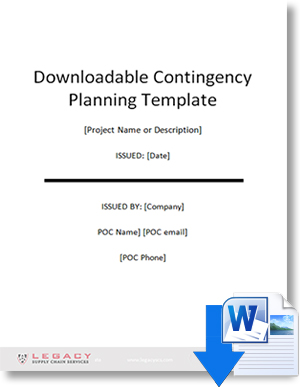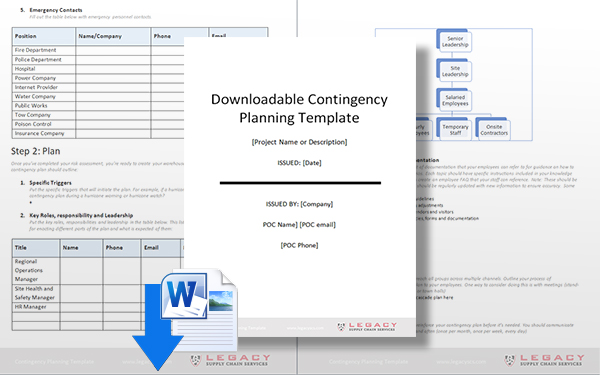COVID-19 Pandemic Sheds New Light on the Need for a Supply Chain Logistics Contingency Plan

The ongoing COVID-19 pandemic has taken a serious toll on businesses across all industries, and supply chain companies including logistics and warehousing operations are no exception.
COVID-19 Supply Chain Disruptions
According to a recent survey from the Institute of Supply Management (ISM), nearly 75% of companies report supply chain disruptions in some capacity due to coronavirus-related transportation restrictions.
Furthermore, 16% also report adjusting their revenue targets downward an average of 5.6% as a direct result of coronavirus.
“The story the data tells is that companies are faced with a lengthy recovery to normal operations in the wake of the virus outbreak,” said Thomas W. Derry, Chief Executive Officer of ISM.
Another survey from the MIT Center for Transportation and Logistics (MIT CTL) revealed an alarming statistic: Only 16% of respondents mentioned that their company has set up an emergency management center.
When asked whether they believed that coronavirus-related disruption would change how their company operates its supply chain in the future, nearly a third of respondents expressed that they felt that their company should have better risk management protocols in place.
These responses are indicative of a larger issue within the supply chain logistics industry - an issue that does not stem from the current COVID-19 crisis but is further compounded by it: the lack of a logistics contingency plan.
What is the Bullwhip Effect?
In our closely connected world, events that take place in one location can have a ripple effect that is felt thousands of miles away. Nowhere is this truer than in the supply chain logistics industry, which consists of a global, interdependent network of raw materials suppliers, manufacturers, carriers, distributors, wholesalers, and retailers. This network is set up in such a way that events that transpire at one point along the supply chain can have serious downstream repercussions throughout the rest of the supply chain.
Perhaps the best-known example of this is the bullwhip effect. The Wall Street Journal describes the bullwhip effect is a phenomenon that “occurs when companies significantly cut or add inventories. Economists call it a bullwhip because even small increases in demand can cause a big snap in the need for parts and materials further down the supply chain.” Also known as the whiplash effect or the Forrester effect, this concept is attributed to renowned computer engineer, systems scientist, and former MIT professor Jay Wright Forrester, who first wrote of it in his 1961 book Industrial Dynamics.
The bullwhip effect can occur for any number of reasons, from price fluctuations caused by special discounts to a lack of communication between different links in the supply chain. We’ve recently seen how the implementation, whether real or anticipated, can create significant ramping up of inventories received from overseas. Natural disasters and global pandemics can also cause the bullwhip to “snap.”
In the case of the current COVID-19 outbreak, the panic buying and hoarding of essentials such as food, paper goods, and sanitary products have radically skewed demand patterns, making it difficult for vendors throughout the supply chain to generate accurate forecasts.
In this sense, a supply chain is something like a series of dominoes - and without a logistics contingency plan in place, the whole supply chain can topple.
Pivoting Your Supply Chain Strategy
If your business is feeling the effects of COVID-19, use this as a learning opportunity, and pivot your supply chain strategy accordingly. Some immediate takeaways:
- Diversify your supply chain. Much of the disruption stemming from the coronavirus outbreak is a direct result of companies relying on a single supplier. Many of these suppliers have experienced labor shortages or even complete closure due to COVID-19, leaving businesses further along in the supply chain unable to meet demand. Although working with new suppliers can be challenging - even risky, in some situations - it’s far preferable to losing your only supplier.
- Make visibility a priority. Look to partner with transportation providers that offer not only real-time web tracking and auto-notifications, but also additional visibility and connectivity to various upstream and downstream supply chain partner activities. Gaining visibility into the inner workings of your supply chain can go a long way toward providing exceptional consumer service and driving customer retention.
- Create flexibility in your multi-channel distribution strategy. One of the big lessons businesses have learned from this crisis is that relying on a single channel to provide goods and services to consumers is an unsustainable approach. Whether it’s restaurants shifting to online takeout orders or retailers adapting to 100% online sales, a flexible, omnichannel distribution strategy is a must. The key for most businesses that sell products to an end customer is the ability to synchronize inventory across all sales channels. A synchronized, omnichannel inventory will enable order fulfillment through all sales channels from inventories in your warehouse, your retail stores, or even your suppliers’ warehouses via dropship. This level of inventory optimization enables businesses to maintain an edge during the current crises, as well as to adapt to new consumer trends as they happen.
Read the Article: 3 Steps to Creating a Warehouse COVID-19 Contingency Plan - Assess, Plan & Communicate
- Look at a near-sourcing model. Companies have struggled to accommodate the soaring demand for essential goods in the wake of the COVID-19 crisis. This issue has been further compounded by the fact that these products are often sourced from suppliers overseas that have also been devastated by lockdowns. To reduce delivery lead times, consider near-sourcing as a fallback option, if not ultimately a primary source of goods and component supply. As an added bonus, near-sourcing will support future logistics contingency plan efforts by making it easier for you to conduct facility visits with your suppliers.
- Diversify your carrier and logistics services provider base. Having multiple options in your international and domestic carrier base is always a smart move. This strategy enables businesses to overcome fluctuations in capacity and transportation costs that come from any number of normal or abnormal circumstances. A mix of asset-based carriers and non-asset-based carriers, including third-party logistics providers, freight forwarders and non-vessel-operating common carriers, will enable you to pull levers as needed to keep your freight moving.
How to Build a Logistics Contingency Plan for the Future
Although it might be a bit late to create a supply chain contingency plan for the COVID-19 crisis, there’s never a bad time to start planning for the future. Here are a few best practices to help you develop a logistics contingency plan that will steer your business through any events that might disrupt your supply chain:
- Be flexible. Short of gazing into a crystal ball, there’s no way for you to account for every possible scenario that might occur. The good news is that contingency planning is designed to be an ongoing and iterative process, one that is adaptable to changes over time. Plan for what you can, stay informed about factors that might change your plan, and build flexibility into your processes so that you can plan accordingly.
- Focus on supply chain visibility. Despite being listed as a top priority year after year, as recently as 2017, only 6% of companies reported that they have full visibility into their supply chain. A lack of visibility can cause you to turn a blind eye to weak spots in your supply chain, which can, in turn, leave you vulnerable to unforeseen events. Supply chain visibility solutions are an invaluable resource for mapping and monitoring your global supply chain so that you’re aware of potential disruptions well before they happen and can adjust your plan as needed.
- Subscribe to Murphy’s Law. According to Murphy’s Law, “Anything that can go wrong will go wrong.” When it comes to supply chain disruption, always expect - and plan for - the worst. Figure out well in advance how you intend to respond in different disruption scenarios, develop a backup plan for each step of your supply chain in case any should fall through, and clearly communicate to your employees their roles and responsibilities. This will not only help you mitigate the effects of any potential disruption, but also bounce back from disruptive events that much sooner.
- Develop a strategy for emergency shipments. As we’ve seen in the case of COVID-19, emergency shipments become a top priority in disruption scenarios. Carefully consider your transportation needs prior to evaluating carriers in order to ensure that they can meet your mission-critical requirements and maintain the flow of goods, even in an emergency situation.
- Create multiple contingency plans. There’s only one thing better than a logistics contingency plan, and that’s multiple logistics contingency plans. Have a plan A, B, C, and so on in place so that your business is ready for anything; this goes a long way toward ensuring that your larger supply chain strategy is as flexible as it needs to be.
About the Author
Kyle Krug has 20 years of professional experience in marketing & strategy, technology & information management, business development, and operational support positions in B2C and B2B services industries. Kyle Krug leads Marketing & Communications for LEGACY Supply Chain Services, with past roles as the Director of Client Solutions for Griffin Global Logistics, and Marketing Manager/Data Analyst in the Hotel Casino industry.
Related Article: 3 Steps to Creating a Warehouse COVID-19 Contingency Plan - Assess, Plan & Communicate
Related Resource
Warehouse Contingency Planning Template
We’ve taken the guesswork out of warehouse contingency planning with this downloadable editable template; from performing a risk assessment to testing out mock emergency scenarios, we’ve detailed every step of the process and made it easy for you to document policies and procedures, so you’ll know exactly what to do should disaster strike. Download Now!
More Resources from LEGACY Supply Chain Services
Article Topics
LEGACY Supply Chain Services News & Resources
Outsourcing eCommerce Fulfillment to a 3PL Rapidly Improve the Performance of Your Warehouse Logistics 20 Warehouse & Distribution Center Best Practices for Your Supply Chain Warehouse Contingency Planning Template 7 Last Mile Logistics Delivery & Ecommerce Trends You Don’t Want to Overlook Increase Inventory Visibility across Your Supply Chain and Optimize Omni-Channel Fulfillment Omni-Channel Logistics Leaders: Top 5 Inventory Insights More LEGACY Supply Chain ServicesLatest in Supply Chain
TIm Cook Says Apple Plans to Increase Investments in Vietnam Amazon Logistics’ Growth Shakes Up Shipping Industry in 2023 Spotlight Startup: Cart.com is Reimagining Logistics Walmart and Swisslog Expand Partnership with New Texas Facility Nissan Channels Tesla With Its Latest Manufacturing Process Taking Stock of Today’s Robotics Market and What the Future Holds U.S. Manufacturing Gains Momentum After Another Strong Month More Supply Chain
















